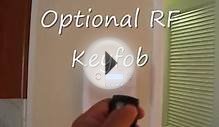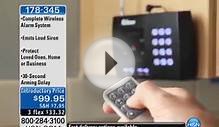
 While there are many benefits of a traditional home security system that is installed by an experienced security professional, there are several do-it-yourself (DIY) systems on the market, and they are easier to install and more affordable than you think. No drilling or technical expertise is required! Plus, most of these DIY systems are wireless, which is great for renters who can’t drill holes in the wall.
While there are many benefits of a traditional home security system that is installed by an experienced security professional, there are several do-it-yourself (DIY) systems on the market, and they are easier to install and more affordable than you think. No drilling or technical expertise is required! Plus, most of these DIY systems are wireless, which is great for renters who can’t drill holes in the wall.
Basic Steps to Installing a Home Security System
1. Install the wireless home security panel.
Choose a place near your primary entry door and close to a power source to install the panel. Often, you’ll only need to hammer a small nail into the wall to “install” the panel. If you can’t put holes of any kind in the wall, you can use removable double sided adhesive.
2. Places sensors and detectors throughout your home.
Your system will include basic door and window alarm sensors, and may include motion detectors. The sensors usually come with a peel and stick backing that holds them into place yet allows them to be moved as needed. Use the guidelines provided with your home security system to place sensors in optimum locations.
3. Test the security system.
Follow the directions outlined in the security system owner’s manual to test the system and make sure everything is working properly.
Key Components of a DIY Home Security System
Security package components vary from company to company, and range from basic to robust. Many DIY home security vendors offer the option of buying components by the piece so you can create a custom home security system. Either way, a DIY home security system consists of the following basic components.
Main Panel with Keypad
The main panel and keypad are the brains of your DIY home security system. You’ll use the keypad to activate and deactivate the system, and if the panel is advanced, you may be able to use it to do things like program alarm settings.
Sensors
Every security system includes window and door sensors that react when the window or door is opened. How many sensors you buy depends on the number of windows and doors in your home, as well as your personal preference.
Motion Detectors
Motion detectors are typically positioned in corners and react when motion is detected in the room. Some advanced motion detectors are paired with security cameras and start recording video when they detect movement. Depending on the system, you may be able to watch the video in real-time from your phone or other Internet connected device.
A DIY Home Security System Isn’t the Right Solution for Everyone
Easy to install, affordable, and powerful, a DIY home security system can help protect a studio apartment in the city or a big house in the suburbs, but it isn’t the right home security solution for everyone. Although DIY home security systems are designed to be installed by non-technical homeowners, some people don’t want to or can’t install the system. And there’s always the chance it will get installed improperly and then you run the risk of going unprotected.
Most DIY system offers don’t offer advanced services or components that traditional alarm systems do, such as fire and carbon monoxide monitoring, panic buttons, or pet-immune motion sensors. And if a component of a DIY system fails, the homeowner is responsible for repairing or replacing it. With a traditional system, the home security company will typically replace faulty equipment for free, or for a minimal charge.
RELATED VIDEO











